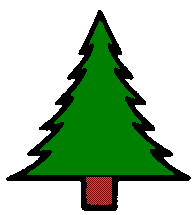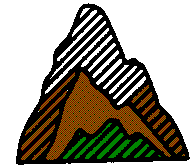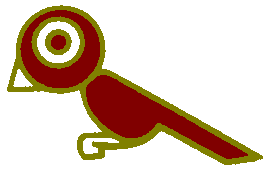The requirements below were effective through May
31, 2015, when the Cub Scout advancement program was completely revised.
For the current requirements for the Webelos
Badge, Click here.
For the current requirements for the
Arrow of Light,
Click here.
As of June 1, 2015, the Webelos Activity Badges have been discontinued.
However,
Webelos Scouts working toward the Arrow of Light,
can continue to use the old requirements until they earn the Arrow of Light.
These requirements were from the 2003 edition of the Webelos Handbook (#33452).
To see the the changes which were made in 2003, Click Here
To see the PREVIOUS requirements (as they appeared in the 1998 edition of the Webelos Scout Book - #33108), Click Here.
Boys who became Webelos Scouts after August 1, 2005, were required to use the requirements below.
FORESTER, GEOLOGIST , NATURALIST, OUTDOORSMAN(**)
** Required for Arrow of Light

FORESTER
| WORKSHEETS | Word Format | PDF Format |
Do five of these:
- Make a map of the United States. Show the types of forests growing in different parts of the country. Name some kinds of trees that grow in these forests.
- Draw a picture to show the plant and tree layers of a forest in your area. Label the different layers. (If you don't live in an area that has forests, choose an area that does and draw a picture of that forest.)
- Identify six forest trees common to the area where you live. Tell how both wildlife and humans use them. (If you don't live in a region that has forests, read about one type of forest and name six of its trees and their uses.)
- Identify six forest plants (other than trees) that are useful to wildlife. Tell which animals use them and for what purposes.
- Draw a picture showing
- how water and minerals in the soil help a tree grow
- how the tree uses sunlight to help it grow
- Make a poster showing a tree's growth rings or examine the growth rings of a tree stump. Explain how the rings tell its life history
- Collect pieces of three kinds of wood used for building houses. Tell what kinds of wood they are and one place each of them might be used
- Plant 20 forest tree seedlings. Tell how you planted them and what you did to take care of them after planting.
- Describe both the benefits and the harm wildfires can cause in a forest ecosystem. Tell how you can prevent wildfire.
- Draw your own urban forestry plan for adding trees to a street, yard, or park near your home. Show what types of trees you would like to see planted.

GEOLOGIST
| WORKSHEETS | Word Format | PDF Format |
Do five of these
- Collect five geologic specimens that have important uses.
- Rocks and minerals are used in metals, glass, jewelry, road-building products, and fertilizer. Give examples of minerals used in these products.
- Make a scale of mineral hardness for objects found at home. Show how to use the scale by finding the relative hardness of three samples.
- List some of the geologic materials used in building your home.
- Make a drawing that shows the cause of a volcano, a geyser, or an earthquake.
- Explain one way in which mountains are formed.
- Describe what a fossil is. How is it used to tell how old a formation is? Find two examples of fossils in your area.
- Take a field trip to a geological site, geological laboratory, or rock show. Discuss what you learned at your next Webelos den meeting.
- While you are a Webelos Scout, earn the Cub Scout Academics belt loop for Geology.

NATURALIST
| WORKSHEETS | Word Format | PDF Format |
Do this:
- With your parent, guardian, or Webelos den leader, complete the
Respect Character Connection.
- Know: Tell what interested you most when completing the requirements for this activity badge. Tell what you learned about how you can show appreciation and respect for wildlife.
- Commit: Tell things that some people have done that show a lack of respect for wildlife. Name ways that you will show respect for and protect wildlife.
- Practice: Explain how completing the requirements for this activity badge gives you the opportunity to show respect.
And do five of these:
- Keep an "insect zoo" that you have collected. You might have crickets, ants, or grasshoppers. Study them for a while then release them. Share your experience with your Webelos den.
- Set up an aquarium or terrarium. Keep it for at least a month. Share your experience with your Webelos den by showing them photos or drawings of your project, or having them visit to see your project.
- Visit a museum of natural history, nature center, or zoo with your family, Webelos den, or pack. Tell what you saw.
- Watch for birds in your yard, neighborhood, or town for one week. Identify the birds you see and write down where and when you saw them.
- Learn about the bird flyways closest to your home. Find out which birds use these flyways.
- Learn to identify poisonous plants and venomous reptiles found in your area.
- Watch six wild animals (snakes, turtles, fish, birds, or mammals) in the wild. Describe the kind of place (forest, field, marsh, yard, or park) where you saw them. Tell what they were doing.
- Give examples of
- A producer, a consumer, and a decomposer in the food chain of an ecosystem
- One way humans have changed the balance of nature
- How you can help protect the balance of nature
- Identify a plant, bird, or wild animal that is found only in your area of the country. Tell why it survives only in your area.
- Learn about aquatic ecosystems and wetlands in your area. Discuss with your Webelos den leader or activity badge counselor the important role aquatic ecosystems and wetlands play in supporting lifecycles of wildlife and humans.
- Look around your neighborhood and identify how litter might be dangerous to the birds and other animals. Clean up the litter. Identify what else you might do to make your neighborhood safer for animals.
- While you are a Webelos Scout, earn the Cub Scout Academics belt loop for Wildlife Conservation.

OUTDOORSMAN
Required for Arrow of Light
| WORKSHEETS | Word Format | PDF Format |
Do two of these:
- Present yourself to your Webelos den leader, properly dressed, as you would be for an overnight campout. Show the camping gear you will use. Show the right way to pack and carry it.
- With your family or Webelos den, help plan and take part in an evening outdoor activity that includes a campfire.
- With your parent or guardian, take part in a Webelos den overnight campout or a family campout. Sleep in a tent that you have helped pitch.
- With your parent or guardian, camp overnight with a Boy Scout troop. Sleep in a tent that you have helped pitch.
And do five of these:
- During a Webelos den meeting, discuss how to follow the Leave No Trace Frontcountry Guidelines during outdoor activities (See page 72.)
- Participate in an outdoor conservation project with your Webelos den or a Boy Scout troop.
- Discuss with your Webelos den leader the rules of outdoor fire safety. Using these rules, show how to build a safe fire and put it out.
- With your accompanying adult on a campout or outdoor activity, assist in preparing, cooking, and cleanup for one of your den's meals. Tell why it is important for each den member to share in meal preparation and cleanup, and explain the importance of eating together.
- Discuss with your Webelos den leader the things that you need to take on a hike. Go on one 3-mile hike with your Webelos den or a Boy Scout troop.
- Demonstrate how to whip and fuse the ends of a rope.
- Demonstrate setting up a tent or dining fly using two half hitches and a taut-line hitch. Show how to tie a square knot and explain how it is used.
- Visit a nearby Boy Scout camp with your Webelos den.







